Western Australia’s Wildflower Wonderland: A Springtime Road Trip Adventure
Imagine this: you’re driving along a dusty red road, the wind in your hair, and suddenly the landscape transforms.
Wildflowers bloom, covering the ground in a vibrant, colourful display that stretches for miles.
While I’ve had the chance to see some wildflowers during my visit from late May to early June, I’ve yet to witness the full spring bloom.
With over 12,000 species of wildflowers, 60% of which are found only in this region, Western Australia is a true wildflower wonderland.
If you’re planning your own adventure, I’ve put together a guide that blends practical tips with poetic inspiration, helping you make the most of WA’s spectacular wildflower season.
When Is Wildflower Season in WA? (Timing by Region)
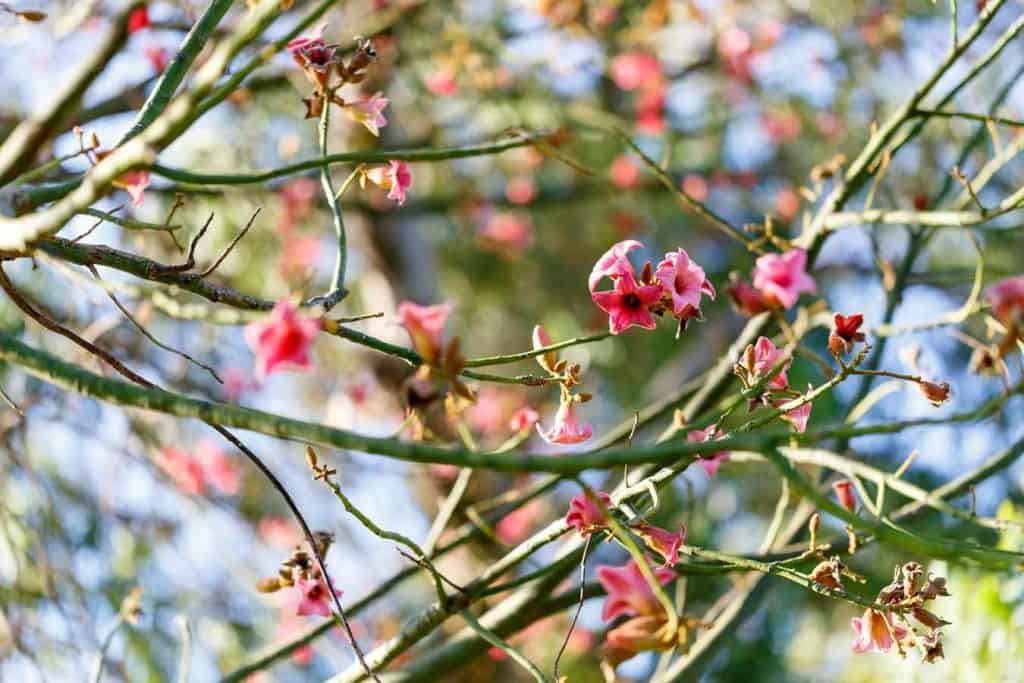
Wildflower season in Western Australia is an incredible six-month spectacle, unfolding in waves of colour from north to south.
It starts as early as June in the far north and Pilbara, gradually moving southward, wrapping up around October or even November on the south coast.
Late winter and spring are prime time for the blooms – August is brilliant for regions north of Perth, while September marks peak bloom season in the southwest, around Perth and beyond.
But as always with nature, timing can be a bit unpredictable – the winter rains can shape when and where the flowers show up.
After a good rainy season, you might see some early colour in the north as early as July, but a dry spell can push back the blooms in the south.
While I haven’t had the chance to see it myself, I’ve heard stories from travellers who’ve hit the jackpot in mid-August near Geraldton, where pink everlastings blanket the landscape after a good rainfall.
By late September, the Perth Hills and Margaret River are often bursting with vibrant orange banksias and kangaroo paws.
The rule of thumb is: head north in August, and south in September for the best wildflower displays.
But if you have the flexibility, planning a trip between August and October gives you the best shot at catching the blooms from both directions.
Keep in mind that the wildflower season is a bit like a natural lottery. The rainfall and weather from year to year dictate how grand the display will be.
Some years, the north steals the show; other years, the southern blooms are the real stars.
I suggest leaving some flexibility so you can follow the advice of locals on what’s blooming where.
Honestly, half the fun is in the search – you never know when you’ll round the next bend and discover a fresh patch of colour.
Where to See Wildflowers: Best Hotspots in WA
Western Australia is vast, and so are its wildflower hotspots. The great news is, you don’t need to visit them all – just a few key stops will give you a diverse and stunning wildflower experience.
Here are some of the favourite places to dive into WA’s wildflower magic:
💐 Mid-West “Wildflower Country” (Geraldton & Surrounds): This region is known for its expansive carpets of everlastings – those beautiful, papery daisies that cover the ground in shades of pink, white, yellow, and purple.
A must-see spot is Coalseam Conservation Park, about 4.5 hours north of Perth, nestled between Mingenew and Mullewa.
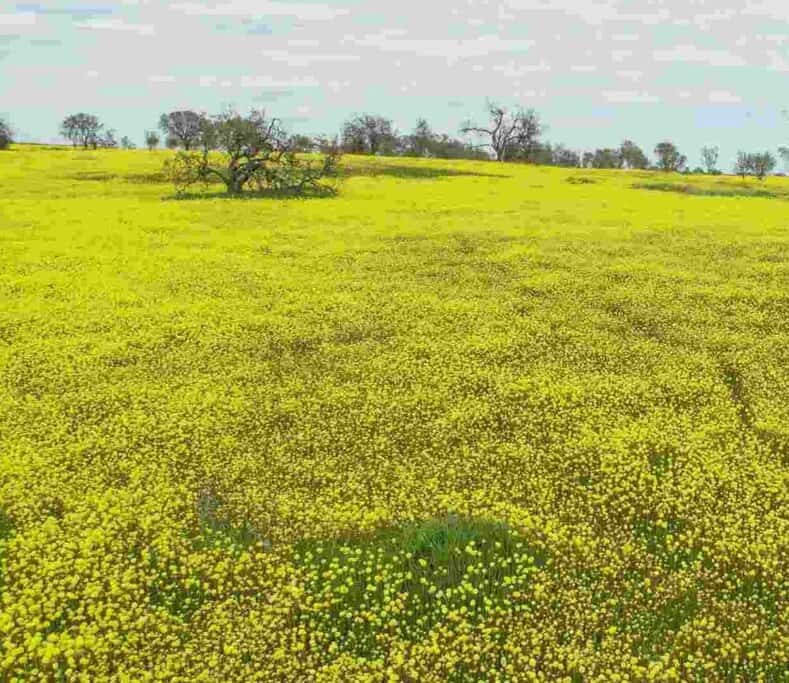
Coalseam is famous for its blankets of pink, gold, cream, and white everlastings that transform the rugged cliffs and red earth in late winter and spring.
The sight of entire hillsides painted in pastel pinks or sunshine yellows feels almost surreal.
You should visit the lookout at Coalseam, looking down at a valley completely covered in wildflowers – it felt like someone had rolled out a giant floral rug.
Nearby towns like Mullewa are also worth checking out – this little gem is home to the rare wreath flower (Leschenaultia macrantha), which blooms in distinctive rings on the ground around late August.
Mullewa also offers a self-guided 3km Wildflower Walk starting at the caravan park, perfect for a leisurely stroll through local blooms.
Geraldton, the main coastal town, makes a great base for exploring this region. It’s got all the city comforts, while still being close to these stunning wildflower hotspots.
From Geraldton, you can easily take day trips inland to places like Pindar (known for wreath flowers along dusty roadsides) and Canna (famous for delicate orchids near a historic dam).
Don’t forget to visit Chapman River Regional Park just outside Geraldton – a short walk there revealed dozens of bush flowers and orchids, all just a stone’s throw from the city.
💐 Coral Coast & Kalbarri (Coastal Drives): If you want to mix ocean views with wildflowers, take the Indian Ocean Drive north of Perth.
Just two hours out, you’ll reach Nambung National Park (home to the famous Pinnacles Desert), known for its haunting limestone spires, but it also hosts seasonal blooms of wattles and yellow tailflower among the dunes.
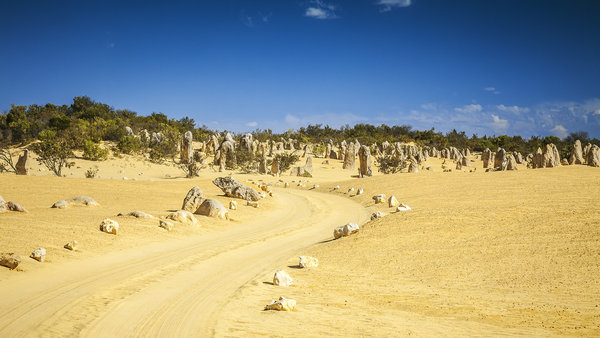
Further north, you’ll find Lesueur National Park, a biodiversity hotspot that contains 10% of WA’s known flora.
Driving the scenic loop through Lesueur in spring, you’ll be treated to a stunning parade of wildflowers along the road – banksias, smoky-grey hakeas, and vibrant fan-flowers.
There are plenty of pull-off points for walking trails, perfect for getting up close with the blooms.
Continue north and make your way to Kalbarri National Park, one of WA’s crown jewels for wildflower enthusiasts.
From July to November, over 1,000 species of native flora burst into bloom around Kalbarri and its striking red gorges.
Many of these flowers are endemic, found only in this region – like the unique Kalbarri spider orchid, with its spindly blooms.
The park’s inland gorge sites (such as Nature’s Window and Z-Bend) are lined with golden banksias, grevilleas in every shade, feathery smoke bushes, and the iconic red and green Kangaroo Paw – WA’s floral emblem!
Even the coastal cliffs of Kalbarri have their own floral delights – look for pink Thryptomene and wild hakea bushes clinging to the clifftops, with orchids hiding in sheltered spots.
Remember to have a morning walk at Mushroom Rock trail, where the clifftop heath was dotted with tiny pink and yellow blossoms, set against the backdrop of the Indian Ocean – absolute magic.
As you head further north toward Shark Bay and Exmouth, the flowering season kicks off earlier.
Shark Bay (around Denham) boasts WA’s longest wildflower season (May to October), with over 700 species blooming across the coastal dunes and plains.
It’s famous for endemic species like the Shark Bay daisy and Tamala rose.
By late winter, the coastal road near Shark Bay can be lined with fluffy white and yellow everlastings, as well as bright Mulla Mulla spires – a striking contrast against the turquoise bays.
💐 Perth & Perth Hills: You don’t have to venture far from the city to experience WA’s wildflower season.
In central Perth, Kings Park hosts the Kings Park Festival every September, where the botanical gardens are packed with thousands of local wildflower species in full bloom.
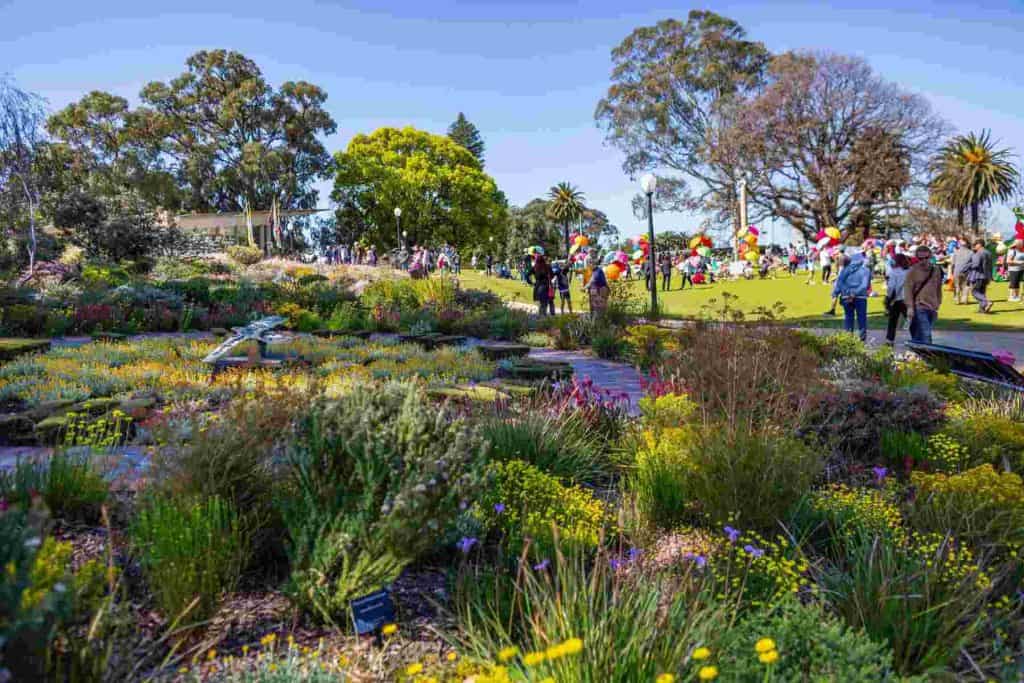
It’s the perfect introduction to the region’s floral diversity – from the fiery red and green Kangaroo Paws to purple native orchids and banksias that look almost as big as beehives.
Insider tip: Visit on a weekday morning for fewer crowds and bring a camera – the displays are absolutely stunning.
A short drive from the city, the Perth Hills and Darling Range come alive in spring.
Head up to places like John Forrest National Park or Serpentine National Park, where the walking trails wind through thick patches of wildflowers beneath the towering jarrah and marri forests.
Keep an eye out for bright Hibbertia (yellow flowers that look like buttercups) along rock outcrops, Hovea bushes with purple pea flowers, and delicate triggerplants and sun orchids peeking through the undergrowth.
Even the road verges in the hills can be full of colour – take a laid-back Sunday drive around Kalamunda or Mundaring, and you’ll spot wildflowers along the roadside.
The Perth Hills are also home to several wildflower reserves, like Ellis Brook Valley, Wireless Hill Park, and Mundy Regional Park, which are popular spots for wildflower spotting and enjoying a picnic with a view.
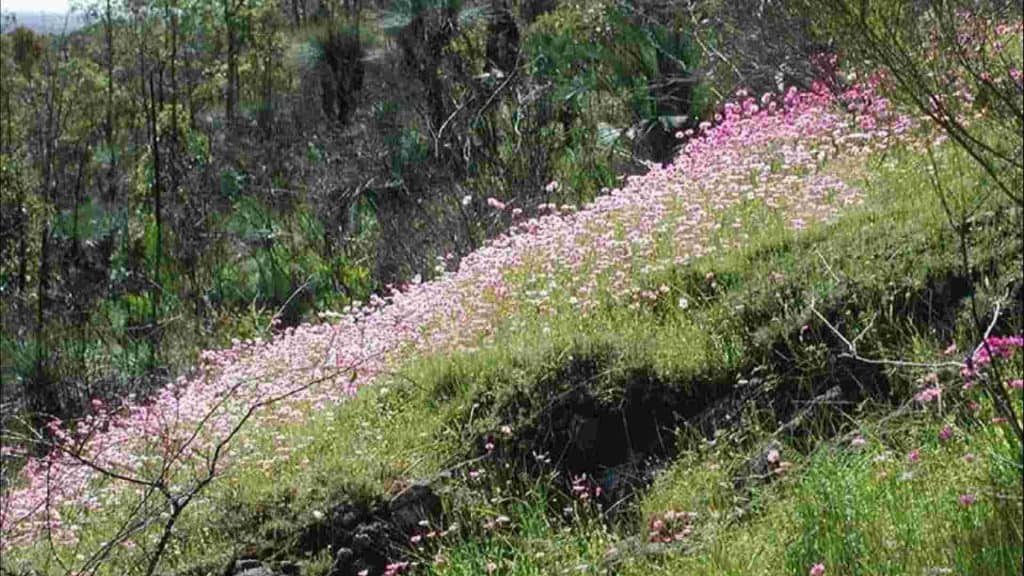
The best part? These places are all within an hour of the city, so you can chase wildflowers during the day and be back in Perth for a delicious meal by night.
💐 South West & South Coast (Fitzgerald River & Beyond): The further south you head, the later the wildflowers bloom – but trust me, it’s worth the wait.
The South West of WA is one of only 36 biodiversity hotspots in the world, boasting an extraordinary variety of plant life.
One must-visit spot is Fitzgerald River National Park, located on the south coast (around a 7-hour drive from Perth, between Bremer Bay and Hopetoun).
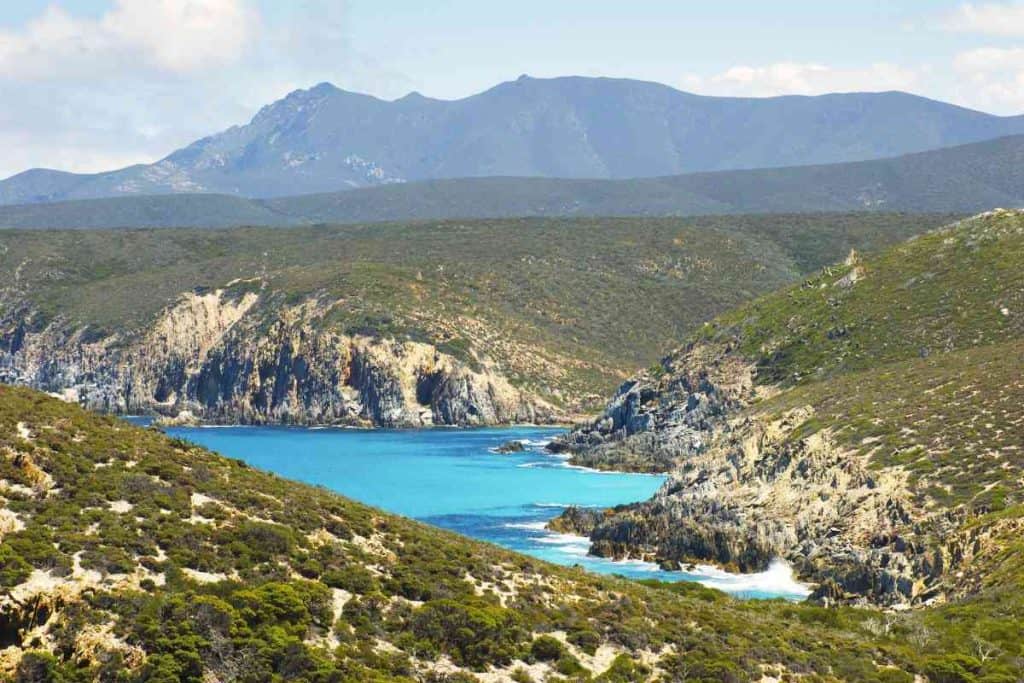
As a UNESCO Biosphere Reserve, Fitzgerald River is home to more than 1,800 species of flowering plants, many of which are truly unique.
Picture royal hakeas with spiky pink flowers, bell-shaped qualup bells, vibrant banksias, and dozens of orchid species.
Try hiking there, and you’ll notice the strange beauty of things like the Royal Hakea (which resembles a spiky ping-pong ball) and the bold, red Bottlebrush grevilleas.
The park’s coastal heathlands in September were like a painter’s palette scattered across the hills – every twist and turn of the trail revealed new colours.
Another highlight in the south is Cape Le Grand National Park, near Esperance, where wildflowers fringe the stunning white-sand beaches.
Imagine scrambling over granite domes with pink wildflowers at your feet, and the turquoise ocean stretching out before you – that’s Cape Le Grand in spring.
For something closer to Perth, there are places like the Perth Hills (Darling Scarp) and the Wheatbelt, on the way to Wave Rock, where everlastings and orchids start appearing in late September.
The Stirling Range and Porongurup Range near Albany are also famous for their orchids – wildflower lovers often make a trip just to hunt for rare Spider Orchids and Queen of Sheba orchids.
Finally, the Wheatbelt & Goldfields regions (east of Perth) are worth a mention too. The northeastern Wheatbelt, around towns like Wongan Hills, Perenjori, and Mukinbudin, is famous for everlastings and wreath flowers.
Many country towns host quaint wildflower shows each spring, like the Ravensthorpe Wildflower Show in September, where local volunteers display hundreds of species they’ve collected.
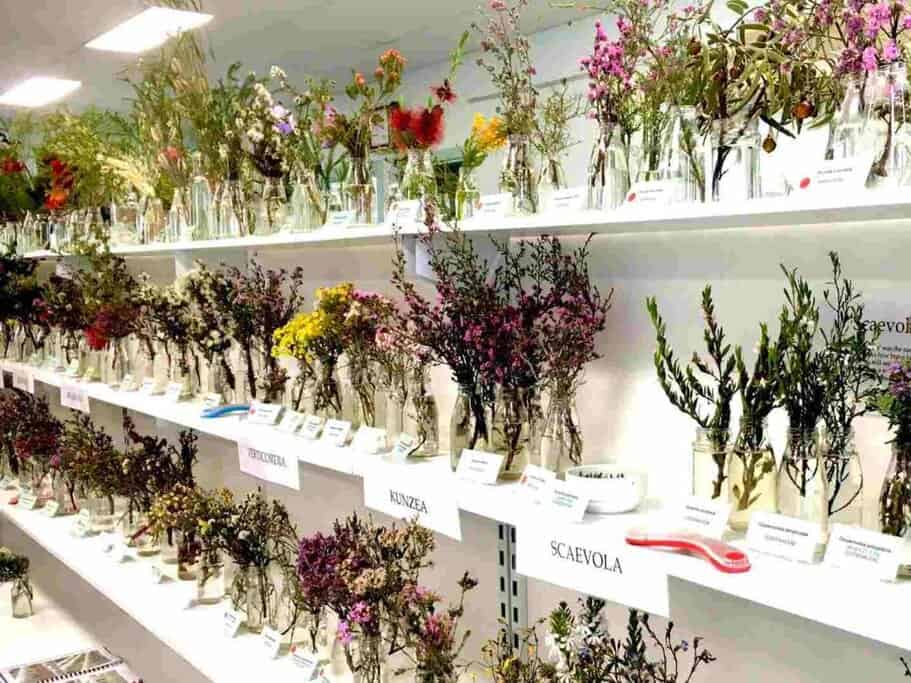
Suppose you head into the Goldfields, around Kalgoorlie and Leonora. In that case, you’ll encounter hardy outback wildflowers like vibrant orange grevilleas and desert peas, which brighten up the red earth – a true testament to the secret garden that emerges in the arid outback after winter rains.
With so many incredible hotspots, my advice is simple: focus on a few key areas rather than trying to see it all.
It’s far more rewarding to spend quality time in one region – walking slowly, snapping photos, and chatting with locals – than rushing across half the state.
Wildflower hunting is just as much about the journey as it is about the destination.
Whether you’re admiring tiny orchids in the Jarrah forest or standing in awe among a sea of a million daisies, you’ll feel the undeniable magic of WA’s wildflowers.
Scenic Drives: Wildflower Self-Drive Itineraries
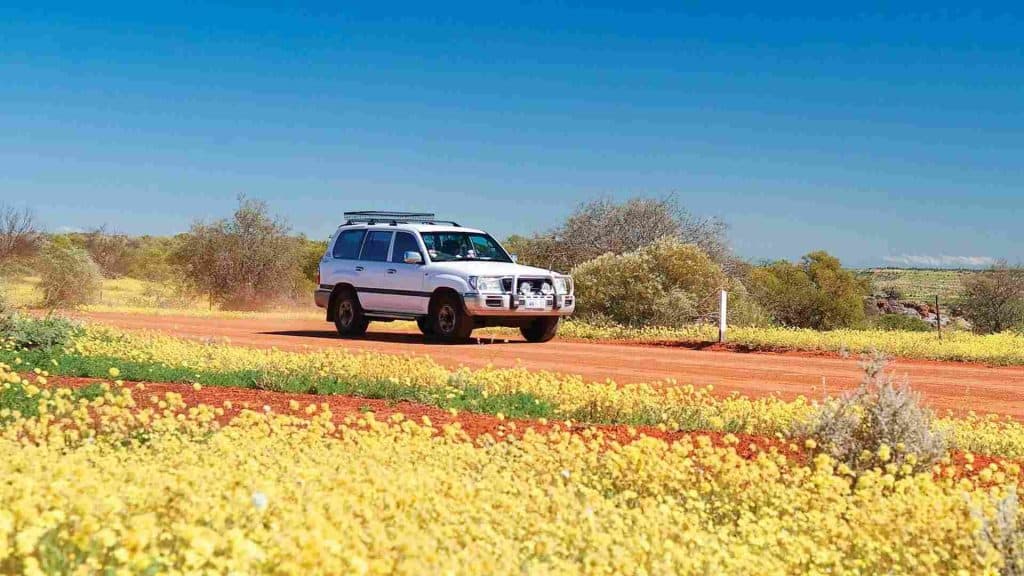
Half the fun of WA’s wildflower season is the road trip itself – cruising along quiet country roads, with the freedom to stop whenever you spot a burst of colour.
Here are some of the go-to self-drive itineraries and scenic routes that combine the best wildflower hotspots with a bit of adventure:
Everlastings Trail (Wildflower Country Loop)
Duration: 3–5 days
Route: Perth → Dalwallinu → Mullewa → Morawa → Perth (loop)
This inland route is all about those iconic everlasting blooms. Start by heading north from Perth into the Wheatbelt.
Around Dalwallinu and Wubin, you’ll begin to spot everlastings lining the highway (I can’t describe the thrill of seeing that first patch of pink!).
Follow the signposted Wildflower Way tourist drive, which stretches from Dalwallinu through small towns like Perenjori, Morawa, and Mullewa – each one known for its wildflower displays.
Along the way, you’ll find wildflower reserves, scenic lookouts, and plenty of local charm.
Many towns even provide maps of recent flower sightings, which you can grab at the local visitor centres.
Must-see stops include Coalseam Conservation Park (a haven for everlastings), the Pindar wreath flower site (usually in full bloom by late August), and Canna, famous for its delicate orchids.
You can loop back via the coastal highway, passing through Mingenew and Dongara, or retrace your steps.
Tip: If you’ve got time, extend the trip further north to include Kalbarri for even more wildflower magic.
Coastal Wildflower Road (Perth to Kalbarri)
Duration: 5–7 days (or longer if you want more beach time)
Route: Perth → Cervantes → Jurien Bay → Kalbarri → (return via inland or same coastal route)
This drive blends stunning coastal views with some of the best wildflower spots in WA.
From Perth, head north along Indian Ocean Drive, making a stop at Nambung National Park (home of the Pinnacles) for a surreal walk among the towering limestone spires and wildflowers.
Then, head to Lesueur National Park, near Jurien Bay – a fantastic spot for wildflower lovers.
I’d recommend taking the 18km Lesueur Scenic Drive, followed by one of the short wildflower walks to get up close to the blooms.
Continuing north, detour to Coalseam Conservation Park (about 1.5 hours inland from Geraldton) if you haven’t yet visited – it’s a must-see during peak blooming season.
From there, push on to Kalbarri, your turnaround point, where you can spend a couple of days exploring the national park’s dramatic coastal cliffs and river gorges, all dressed in wildflowers from July to October.
On your way back, you could stick to the coast (I recommend stopping by Hutt Lagoon near Port Gregory – the pink lake paired with fields of wildflowers and saltbush makes it a photographer’s dream) or take an inland route via Wildflower Country to catch any blooms you may have missed.
By the time you finish this trip, you’ll have a camera full of epic coastal views and close-ups of the wildflowers – a perfect blend of WA’s natural beauty.
Wave Rock & Wheatbelt Explorer
Duration: 4–6 days
Route: Perth → York → Wave Rock (Hyden) → Esperance (Cape Le Grand) OR → return via Wheatbelt
This route is perfect for those wanting to experience outback blooms alongside some of WA’s most iconic rock formations.
Start by driving east from Perth through the historic Wheatbelt towns. Wildflower season coincides with harvest time, so you’ll be treated to a beautiful contrast of canola fields bursting in yellow next to vibrant purple wildflower patches.
Just a heads-up – stick to public roads for photos to respect private land.
Make your way to Wave Rock near Hyden, where the spring wildflowers surrounding the giant granite formation include delicate feather flowers and small orchids.
There’s even a walking trail around Wave Rock designed for spotting blooms up close.
From Wave Rock, you can continue south to Esperance, where Fitzgerald River National Park and Cape Le Grand National Park bloom in September and October, offering a stunning mix of coastal heathland flowers (as mentioned earlier).
This creates a longer loop (about a 10-day round trip), but you’ll experience everything from wheatbelt everlastings to coastal flowers.
If you’re short on time, take the inland route back to Perth via Merredin, Narrogin, and the Dryandra Woodland – this area is known for both wildflowers and wildlife (and if you’re lucky, you might spot a numbat!).
The Wheatbelt route is home to a series of small conservation parks with lovely spring displays, including places like Tutanning Reserve, Boyagin Rock, and Jingaring.
It’s a more off-the-beaten-path wildflower adventure, but one that rewards you with peaceful moments surrounded by blooms.
South West Wildflower Trail
Duration: 7–10 days (flexible)
Route: Perth → Margaret River → Pemberton/Walpole → Albany → Stirling Range → Perth
The south-west corner of WA is a must-see, especially for its later wildflower season (September–November) and distinct flora. Start your journey in Margaret River, where you can mix wine tasting with wildflower walks in the Boranup Forest or along the Cape to Cape Track.
If you join a short guided walk on the Cape to Cape section, you might see a range of plants – kangaroo paws, karri hazel, wild clematis, and countless colourful shrubs.
From Margaret River, head east through the towering timber country of Pemberton and Walpole, where the forest floor bursts with blooms like purple hoveas and delicate orchids.
Near Albany, the coastline of Torndirrup National Park and Two Peoples Bay is home to royal hakeas and banksias.
Finally, spend a couple of days around Stirling Range National Park – a place where it sometimes even snows, believe it or not!
This area is an orchid lover’s paradise. You can hike up Bluff Knoll (if you’re feeling fit) for panoramic views, or stroll along the lower trails spotting the brilliant red firewheel banksia (banksia coccinea) and a variety of fascinating flowering bushes.
For the return leg, head back to Perth via the Great Southern Highway, making stops at wildflower hotspots in October like the Porongurup Range or Foxes Lair in Narrogin (a charming reserve known for its blooms).
This itinerary is a dream for flower enthusiasts, while also showcasing WA’s towering forests and stunning southern coastline – a well-rounded road trip that offers a bit of everything.
Tips for Wildflower Photography & Travel in WA
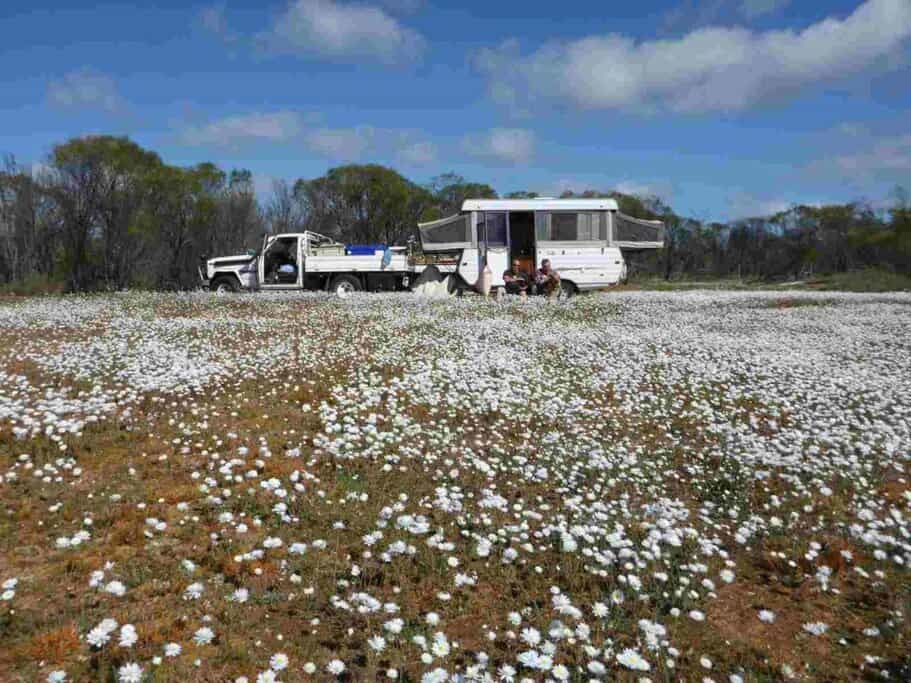
Chasing wildflowers is an adventure in itself, and a few handy tips can make it even more enjoyable.
Over the years, I’ve picked up a few tricks (sometimes the hard way) on how to get the best photos and stay comfortable while out on the road.
Here are my top tips for your wildflower trip, but please note that I’m not a photography expert!:
📸 Respect the Flowers and the Land
It’s tempting to pluck that perfect bloom for a quick selfie or a floral crown, but don’t!
Picking wildflowers is illegal, and the fines can be hefty – take photos, not flowers.
Stick to established paths or bare ground when walking among the blooms to avoid crushing plants.
I’ve seen plenty of people lying down in a field of everlasting for that perfect shot – fun, but remember to watch where you step when you leave.
And if you spot a stunning paddock of canola or wildflowers on private farmland, admire it from the fence unless it’s open to the public. Trespassing isn’t worth the risk.
📸 Any Camera Works – Just Work the Angles
You don’t need a fancy camera to capture WA’s wildflowers. I’ve snapped beautiful shots with just my smartphone.
The secret lies in the lighting, angles, and stability. Early morning or late afternoon is the best time to shoot – the light gives everything a warm glow and often the breeze is gentler, reducing blur on delicate petals.
Try getting low to get an eye-level shot of a flower against a scenic backdrop. A small tripod or even resting your camera on your backpack can help when it’s windy.
Don’t forget to take wide shots to capture the vast landscapes of colour, but close-ups are just as important.
The details of an orchid or the texture of a banksia cone are incredible when you take a moment to really look.
📸 Plan and Book Ahead
Spring is peak travel season in many of these regions, so it’s wise to plan ahead. Accommodation in small towns can fill up quickly once the wildflowers start blooming.
Campgrounds can be especially tricky – many are first-come, first-served, so it’s best to arrive by mid-afternoon to secure a spot.
Also, fuel up whenever you can and carry plenty of water and snacks – roadhouses can be spaced far apart in the outback, and nothing’s worse than being dehydrated while flower-spotting under the sun.
📸 Weather and Gear Prep
WA’s spring weather can be unpredictable. Mornings can be chilly (near 5°C in some inland spots), but by midday, it can warm up to the mid-20s°C or higher.
Layer up so you can peel off jackets as the day heats up – I usually start in a jumper and beanie in the morning and switch to a T-shirt by lunchtime.
A lightweight rain jacket is also a good idea, especially down south, where spring showers are common.
Sturdy walking shoes or boots are essential for trekking through rocky areas and trails.
And don’t underestimate the Aussie sun – even in spring – so make sure you’ve got sunscreen, a wide-brimmed hat, and sunglasses.
Insect repellent is a must, too; after a wet winter, the mozzies and flies can be enthusiastic.
📸 Road Safety for Flower Gazers
We’ve all been that person who spots an incredible patch of wildflowers just off the highway.
By all means, stop and enjoy – but do it safely. Use designated pull-offs or rest areas whenever possible, or ensure you can get your vehicle fully off the road.
Instead, note the spot and turn around when it’s safe to do so, or park further up the road and walk back carefully.
Always prioritise safety, even when wildflower fever takes over!
📸 Local Knowledge is Gold
Lastly, talk to the locals. Fellow travellers, park rangers, café owners – everyone has a “you must check out xyz” tip.
Be sure to stop by the visitor centres in the towns you visit – many have wildflower display boards or will happily mark up a map with the current flower hotspots.
It’s like a treasure hunt, and the clues are all freely given!
Where to Stay: Accommodation in Wildflower Regions
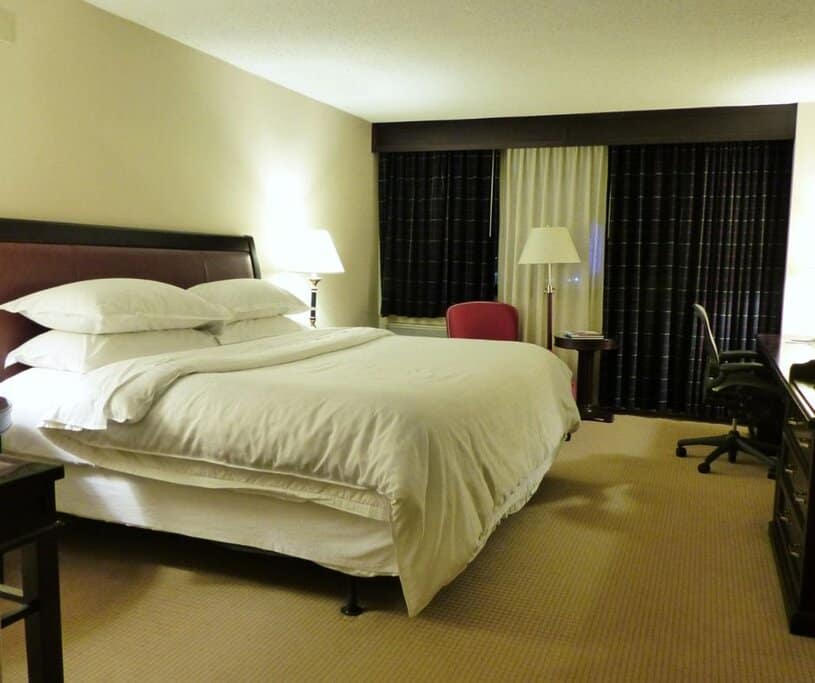
After a big day chasing wildflowers, having a comfy spot to crash makes all the difference. Across WA’s wildflower regions, there’s everything from quiet bush camps to charming B&Bs and no-fuss hotels. These are a few spots, along with some handy tips for where to stay.
Geraldton & Mid-West Bases
Geraldton’s a solid base when exploring the Mid-West wildflower region.
It’s the biggest town along the Wildflower Coast, so you’ll find plenty of places to stay—hotels, motels, and self-contained apartments.
I recommend the Geraldton Ocean Centre Hotel for the location alone. Right on the foreshore and walking distance to cafes, shops, and some seriously good seafood. Plus, it’s easy to stock up at the local supermarkets before heading inland.
If you’d rather be closer to the blooms, there are a few smaller inland towns that do the trick. Mullewa, Morawa, Perenjori, and Dalwallinu all have simple motels or low-key caravan parks run by the shire.
You can also check out Mullewa’s caravan park, which was cheap and cheerful – bonus: it was the trailhead of the wildflower walking trail, so you will literally step out of your campervan and into a field of everlasting at sunrise!
Just a heads up, these spots fill quickly during peak season, so it’s best to book in advance or rock up early if you’re aiming for an unpowered site.
Kalbarri
Kalbarri’s a great spot to base yourself if you want to see wildflowers alongside beach vibes.
It’s a proper tourist town, so you’ve got loads of choice—holiday parks by the river, motels, resorts, and good old-fashioned camping.
I suggest staying at Kalbarri Edge Resort, but there are also some lovely family-run motels and a caravan park located right on the waterfront, offering river views from your tent or van.
What’s handy about staying in town is how close you are to both Kalbarri National Park and all the local bits like shops, pubs, and cafes.
In the evening, you can wander down the foreshore or catch the pelican feeding in the morning—it’s those little extras that make Kalbarri more than just a wildflower stop.
Just keep in mind, it’s a popular place even without the wildflowers, so if you’re heading up in late winter or spring, especially around school holidays or long weekends, book ahead or risk missing out.
Perth Hills & Surrounds
Chasing wildflowers around Perth and the Hills is easy with plenty of stay options depending on how far you want to roam.
You can base yourself in Perth City and do day trips—places like Avon Valley and Julimar are a breeze, while somewhere like Wave Rock is a longer drive but still manageable if you’re up for it.
If you’d rather slow down and stay out in nature, the Perth Hills have some lovely little farmstays and B&Bs.
Think cosy cottages in Kalamunda or Mundaring, birds waking you up, and walking trails right on your doorstep.
If you’re into camping, national parks like Lane Poole Reserve near Dwellingup are great for bush camping, with jarrah forest and wildflowers all around.
The Perth Hills don’t book out as quickly as the more remote regions, but weekends in wildflower season can still get busy—everyone’s out soaking up the spring sunshine.
For something a bit special, I’d look at chalets around York or Mount Helena.
Some spots even do glamping setups with wildflowers just outside your deck. It’s a nice way to do nature without giving up a comfy bed.
Fitzgerald Coast (Hopetoun & Bremer Bay)
Fitzgerald River National Park is massive and untouched, with no proper accommodation inside—just a few basic campgrounds.
Most people stay in the little coastal towns on either side. Hopetoun, on the eastern edge, is a sleepy seaside town about 15 minutes from the park.
It’s small but has what you need—motels, a caravan park, and a few beachside cottages.
I recommend Hopetoun Motel & Chalets. Nothing fancy, but it was clean, comfy, and only a short stroll to the beach for sunset.
There’s a pub for meals, one grocery store, and plenty of friendly locals happy to share which park tracks are open—some close in spring to protect fragile areas.
On the western end, Bremer Bay is another peaceful coastal village. It’s known more for orca tours in summer, but it’s also a great base for the park.
There’s a neat caravan park and a few lodges or small resorts tucked among the trees.
Whether you stay in Hopetoun or Bremer Bay, you’ll be close enough to spend your days wandering through wildflower country and your nights somewhere warm and quiet.
These towns are tiny, though, so don’t risk turning up without a booking—places fill fast during peak season.
If you’re camping, there are a few park-run sites worth checking out: Four Mile Beach and St Mary Inlet on the east, or Point Ann on the west.
Facilities are basic—think drop toilets and no power—but the trade-off is waking up in pure wilderness with wildflowers at your doorstep.
Camping & Station Stays:
If you’re into camping like I am, WA’s wildflower regions are perfect for nights under the stars.
Coalseam Conservation Park is one of the best spots, with two campgrounds right in the thick of the blooms.
There’s no drinking water, but toilets are available, and the everlastings at dawn are something else.
At night, you might even hear desert frogs down by the river—magical stuff. A lot of national parks and nature reserves offer basic campsites too, usually first-come, first-served.
It’s worth having a backup plan in case you rock up and it’s already full. Mid-week tends to be quieter, so I often camp then and leave town stays for the busier weekends.
Another great option is station stays. These are working cattle or sheep stations that open their doors to travellers.
Wooleen Station, north of Geraldton in the Murchison region, is a good one. During wildflower season, the landscape there really puts on a show.
Staying on a station gives you a proper outback feel—wide open skies, red dirt roads, and some of the best stargazing you’ll find anywhere.
The Wrap-Up
Wildflower season in WA really is a choose-your-own-adventure. Whether it’s the first bursts of colour up north or the last blooms down south, there’s something special around every corner.
Pack the car, bring your camera, and leave room for a few surprises along the way—this is one road trip you’ll remember.
